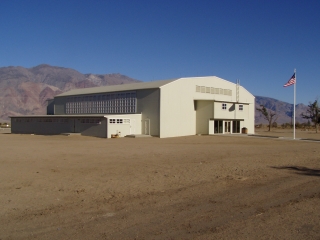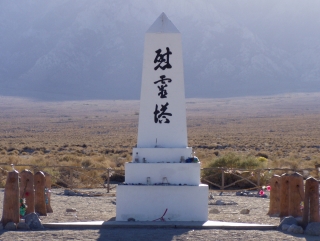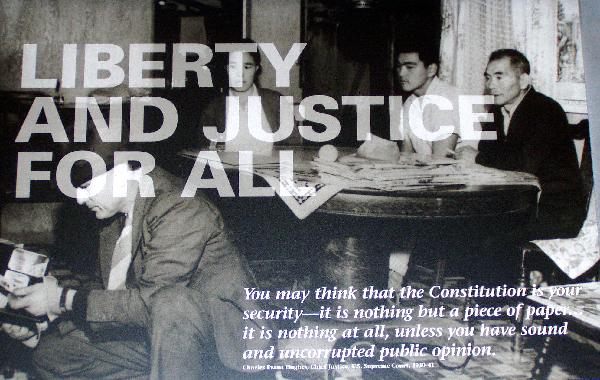NPS Website; Local Website
 WHAT IS IT?
WHAT IS IT?Manzanar NHS remembers the forceful detainment of ten of thousands of American citizens of Japanese descent during World War II. Manzanar was the site of one of ten “War Relocation Centers”.
BEAUTY (6/10)
If Japanese-Americans had freedom of movement in and out of the camp, and had actually chosen to be there, Manzanar might have been an idyllic place. It is hard to appreciate the grandeur of the Sierra Nevadas and the peaceful valley oasis when it is so far away from the home and life you made for yourself along the West Coast. Residents of Manzanar did as much as they could to beautify their hastily constructed surroundings. Remains of orchards and rock gardens still remain.
HISTORICAL INTEREST (8/10)
After Japan attacked Pearl Harbor, Japanese-Americans were singled out as the most visible threat to national security. War Relocation Centers, authorized by President Franklin D. Roosevelt’s Executive Order 9066 in February 1942, allowed for the relocation of 120,000 Americans of Japanese descent from the Coastal cities of the United States. Two-thirds of those interned at Manzanar were American citizens by birth. Most of those kept here were not enemy combatants or aliens; they were American citizens. A good number of the remaining one-third had lived in the U.S. for years but were denied citizenship through law.
Manzanar was in use from March 1942 until three months after the Japanese surrender in November 1945. At its population peak, over ten-thousand people lived in the 500-acre housing area.
CROWDS (8/10)
We pulled into the parking lot as a caravan of antique cars were being admired by site visitors and staff alike. The car tour had thought enough of Manzanar NHS to stop, as did a fair number of tourists. Manzanar probably benefits from its location on a main road connecting the Inyo National Forest and Mount Whitney Portal to Death Valley NP and Mammoth Lakes, a popular resort area.
The Site’s Interpretive Center is located in the Relocation Center’s renovated auditorium. Space was so well appointed that visitors, and later a large group from a nearby community college, could move about the exhibits, never feeling rushed or cramped.
Manzanar NHS, like the Truman Presidential Library, has a large guest book where visitors can log their comments about the Site and the events it memorializes. Whereas reading the Truman book made Gab cry, flipping the pages of Manzanar’s guest book gave us hope for a more understanding America. The crowds at Manzanar NHS affected our visit in a positive way.
 EASE OF USE/ACCESS (3/5)
EASE OF USE/ACCESS (3/5)Manzanar NHS is located directly off U.S. Highway 395, 9 miles north of Lone Pine, California. The Site is 50 miles from the western entrance to Death Valley NP and 100 miles south of Mammoth Lakes, California. One can also access Yosemite NP by continuing for 50 miles north on the same road. It took us almost 4 hours to reach Manzanar from Los Angeles.
The Interpretive Center just opened in April 2004. The building is fully accessible. The grounds of Manzanar are viewed by taking a self-guided auto tour.
CONCESSIONS/BOOKSTORE (5/5)
Excellent. A huge assortment of books ranging from first person narratives about life at Manzanar to essays opposed to and in defense of the use of detainment filled the shelves in an open, well-lit, friendly space. Some unexpected titles included Japanese language books, how-to origami books and sushi cookbooks. Non-book items included posters, tea sets, dishware, original paintings and children’s games that would have been popular at Manzanar.
If there was a particular title that they happened to be missing, the Manzanar NHS staff told us they would be happy to order it and have it shipped wherever we would like. In fact, they were eager to hear suggestions of what else they might include. We could not think of anything.
COSTS (4/5)
There is no charge to visit Manzanar NHS.
RANGER/GUIDE TO TOURIST RATIO (3/5)
Only one Ranger, a volunteer and an employee of Western National running the bookstore were on hand to accommodate the crowd. All were in the auditorium and eager to answer questions. We encountered one of the most helpful Rangers ever, but felt a little guilty taking up so much of her time when she was the only Ranger available. More staff would compliment the wonderfully done Interpretive Center.
TOURS/CLASSES (10/10)
The key to Manzanar NHS is its tremendous Interpretive Center. The 8,000-sqaure foot Museum is located inside the Relocation Center’s auditorium. Graduations, plays and dances all took place here. Now it serves as a remembrance to a regretful period in American history. The visit begins with an even-handed, touching film centered on present-day interviews of former internees. The typical ups and downs of daily life are recounted: gardening, baseball games, high-school dances and friendship. In the face of forcible detainment and a complete loss of property and former life, those at Manzanar forged ahead and made the most of their lives behind the barbed wire and under the guard towers. Suitably, the first exhibit outside of the theatre is a to-scale model replica of the entire Relocation Center made shortly before the Museum’s opening by the 1942-1945 graduates of Manzanar High School.
One-half of the Museum personalizes the journey even further. You are given a Japanese American identification tag upon entry and come to understand what it was like to be that person. How did the experience at Manzanar change your life? The answers are amazing and the journey of discovery through the Museum is stirring. One display shows what it was like to be a child at Manzanar with period toys and schoolbooks. This exhibit is addressed not to adults but to child visitors. A short mirror, only tall enough for someone shorter than 5’ 0”, stands with a placard reading, “what were people at Manzanar like?” The unsaid answer: just like you.
 The other half of the Museum looks at the broader history of the Relocation Centers, the Constitutional miscarriages and the modern-day relevance of the Site. It is a reminder that this is living history; it can and may be happening today. We must be vigilant in our defense of the Constitution and must fight to ensure that there is no place in America for the curbing of Civil Liberties. That is what freedom is all about.
The other half of the Museum looks at the broader history of the Relocation Centers, the Constitutional miscarriages and the modern-day relevance of the Site. It is a reminder that this is living history; it can and may be happening today. We must be vigilant in our defense of the Constitution and must fight to ensure that there is no place in America for the curbing of Civil Liberties. That is what freedom is all about.FUN (8/10)
We did not expect to have fun at Manzanar NHS. We expected dour reminders of our nation’s wrongs. We expected to learn and leave in a troubled mood. These unavoidable emotions were elicited but trumped by a deep respect and admiration of those interred. The Site emphasizes the people affected just as much as the policies that affected them. It emphasized their heroic responses to their unjust and unconstitutional circumstances. This is their Museum; it is their story. We are thankful that NPS worked so closely with individuals whose lives were changed; thankful that those individuals chose to share memories that perhaps they’d rather forget.
WOULD WE RECOMMEND? (10/10)
The Museum at Manzanar NHS is a masterwork in design, content and experience. It should serve as a blueprint for future historic museums.
TOTAL 65/80
www.usa-c2c.com
© 2004-06